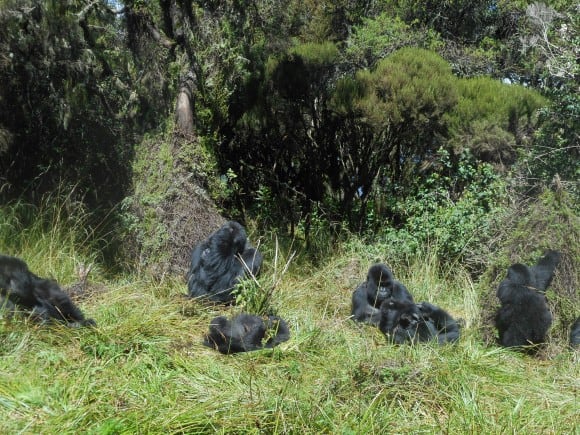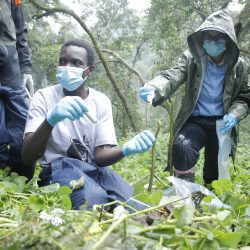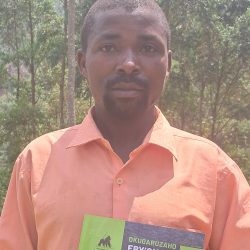Embracing transboundary mountain gorilla movement
Blog | 23/01/20
“Just as animals know no borders, so should we their conservationists if we are to fully achieve our conservation objective” Joseph Arinaitwe, Assistant Warden Ecological Monitoring and Research, Bwindi Mgahinga Conservation Area.
Since the establishment of international boundaries and the national parks where mountain gorillas live, mountain gorilla families in the Virunga massif are known for crossing from one park to another. In more recent years, for instance, Kwitonda group originally from Virunga National Park, DRC, crossed to Volcanoes National Park, Rwanda, in 2003 and has lived there until today. Karisimbi group from Volcanoes National Park previously ranged back and forth from Volcanoes National Park to Virunga National Park until it permanently settled in Virunga National Park in 2017. And most recently Hirwa group from Volcanoes National Park crossed to Mgahinga Gorilla National Park, Uganda, where it is currently ranging.

The Virunga Massif that comprises of Virunga National Park in DRC, Volcanoes National Park in Rwanda, and Mgahinga Gorilla National Park in Uganda is home to at least 604 mountain gorillas according to the 2015 – 2016 Virunga Mountain Gorilla survey.
While it is understood that shifts of home range by a group of gorillas may be caused by several factors, such as search for abundant and or preferred food, civil unrest, or fear of interacting with other gorilla groups sharing the same habitat (for this can result into one group losing its females to a much stronger group), some gorilla groups are simply adventurous – they wish to move and are free to do so.
To the gorillas, it is all but one large habit, one home range. Whereas range states and park authorities alike look at the political boundaries defining each park’s jurisdiction, the amazing mountain gorillas see otherwise. It is one landscape afterall!
Transboundary movement patterns are normal and expected because animals unlike humans cannot know, let alone recognize park boundaries. Sharing the lessons learned from such transboundary movement patterns, Dr. Andrew Seguya, Executive Secretary of the Greater Virunga Transboundary Collaboration (GVTC) says transboundary movements are likely to continue based on gorilla population increase and likely increase in gorilla groups’ / individual’s interactions. “There is need therefore to strengthen the transboundary collaboration processes and the system of information exchange among the range states”.
In 2006, the protected area authorities of the three range states (DRC, Rwanda and Uganda) signed a memorandum of understanding that is a foundation of good will toward collaboration in mountain gorilla conservation and tourism. Collaboration represented by this MoU and the subsequent Treaty on the Greater Virunga Transboundary Collaboration on Wildlife Conservation and Tourism Development has been the cornerstone of the success of conservation efforts leading to the change of status from Critically Endangered to Endangered.
According to Anna Behm Masozera, Director for the International Gorilla Conservation Program, “the situation with the mountain gorillas continues to evolve, and the more we can do to enhance trust and collaboration, as well as monitoring and protection, among range States through these agreements and collaborative actions, the more we can sustain this success long into the future”.
Although the original institutional parties to the MoU no longer exist, the good news is that the GVTC Treaty now provides a framework for collaboration for the three sovereign range States under which the prior MoU can be reviewed, assessed, and put in practice within the region.
The transfer or relocation of one mountain gorilla group from one park in the massif to another should therefore not cause any alarm or misunderstanding among the public or political institutions in the range States but rather evoke an appreciation of the mountain gorillas’ transboundary nature and remind the authorities to embrace and maximize the existing framework to ensure their safety and that they continue to play their tourism function regardless of where they are.

The media and the private sector need to do a better job reporting on and show casing the benefits of transboundary collaboration for mountain gorilla conservation and help the public to understand and appreciate transboundary movement patterns and how they are managed.
Assessing the effectiveness of the signed MoU, Dr. Andrew asserts that the MoU is still playing effectively and being referred to in case of any transboundary gorilla movements. “It has been the basis for revenue sharing between the origin and host countries, particularly in the case of Kwitonda Group”. The MoU stipulates that the tourism revenue from a transboundary group shall be split into 50% each between the host and origin countries. And according to Eugene Mutangana, Conservation Management Expert at Rwanda Development Board, this arrangement has worked fairly well between Rwanda and DRC, while recognizing different contexts in terms of pricing and other factors between the countries.
The GVTC secretariat needs to continue bringing all people together and make them realize that we work for the same goal and actively work to harmonize any existing differences and gaps in the treaty that have the potential to erode the existing transboundary collaboration.
The onus therefore is also upon range states and specifically park authorities in the transboundary area to overlook their political boundaries and differences for the sake of mountain gorilla conservation and then collaboratively work together to secure the future of the mountain gorillas and their habitat. And they need help from the media, who can very quickly sensationalize what is a normal, ecological process, the foundation for the future of mountain gorilla conservation, which should be embraced and celebrated.
Although mountain gorilla tourism has evolved differently in the three countries, it remains the biggest tourism project across the board. The mountain gorilla continues to be the biggest tourist attraction in all the three countries; bringing in the most tourism revenue and making considerable contributions to the economic development of the respective countries and livelihood improvement of the park adjacent communities.



